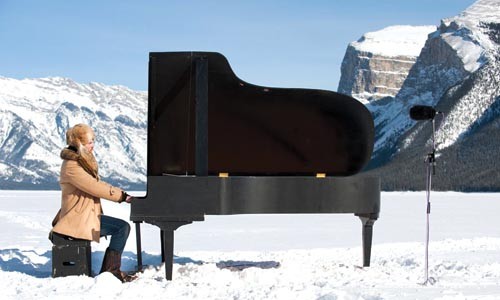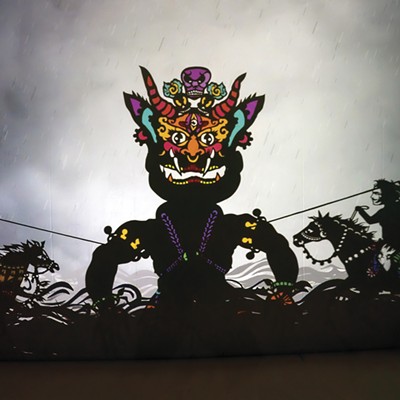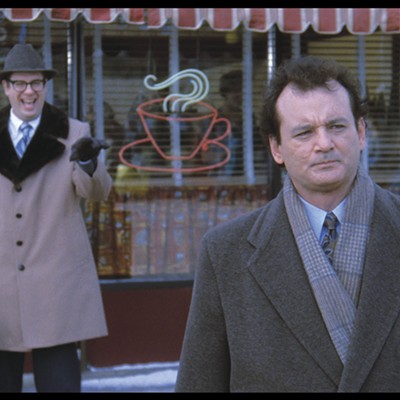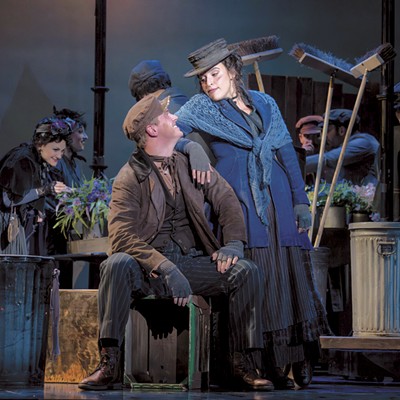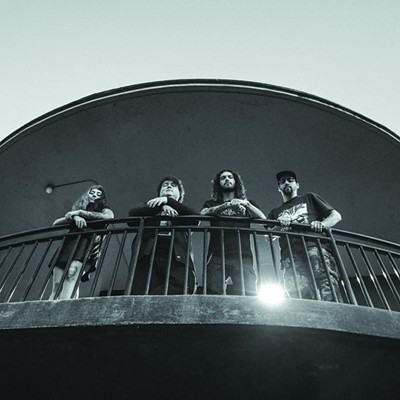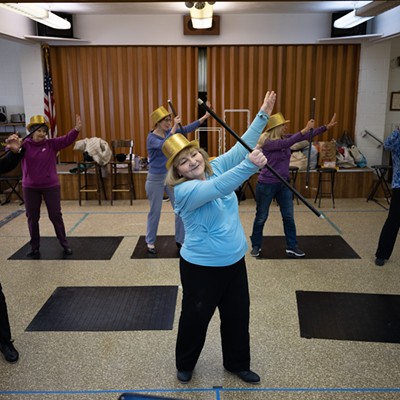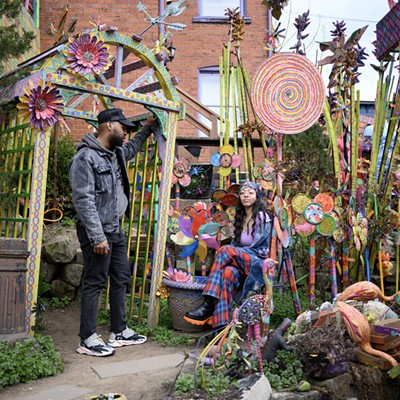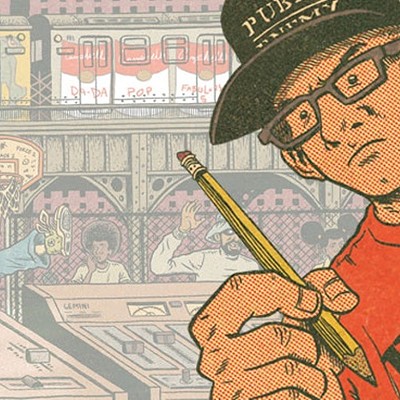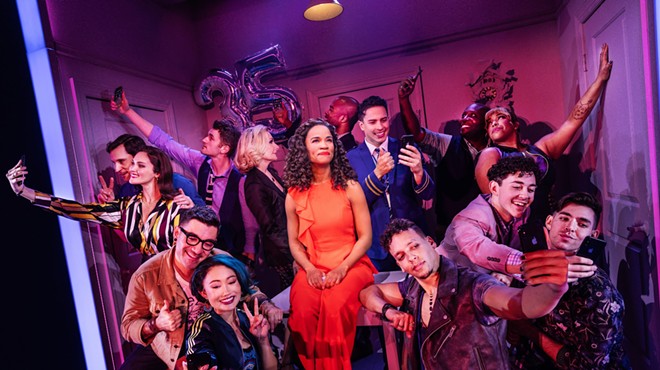Davíð Þór Jónsson strides down Craig Street on a sunny afternoon, in sunglasses and an overcoat, his long hair slicked back, a bemused grin behind his full beard. As Jónsson, a musician, and his artist companions cut a path through the college students, they give the impression they've just arrived from another, more colorful dimension. Or perhaps just from Iceland. Ásdís Sif Gunnarsdóttir carries a baby in a sling, under some sort of cloak; her husband, Ragnar Kjartansson, in a heavy flannel shirt and cap despite the warm day, pushes an empty stroller.
"Art-world gypsies" is how Kjartansson jokingly described them earlier, during our interview at the nearby Carnegie Museum of Art. He then laughed and shook his head. "So much cooler to be a real gypsy."
This contingent from Reykjavík has spent the past month lodged in Shadyside while fashioning Kjartansson's site-specific works at the Carnegie. One of these is a performance on Thu., March 24, titled "An Evening With Ragnar Kjartansson and Friends." With music, poetry, theater and other elements they're still working out, Kjartansson describes it as "a vaudeville show -- Ingmar Bergman-style vaudeville."
Now in his early 30s, Kjartansson played in Icelandic synth-based band Trabant and studied art both at Stockholm's Royal Academy and the Icelandic Academy of the Arts in Reykjavík. In art school, he says, his teachers urged him to focus, but Kjartansson instead embraced the multi-platform, multimedia approach that felt more natural.
Song, his exhibit running at the Carnegie through Sept. 4, gives a taste of Kjartansson's kaleidoscopic work. There's the video "Satan Is Real," in which Kjartansson, buried to the waist in a green hillside and shirtless, strums a guitar and sings his dark interpretation of the old country song by the Louvin Brothers. Then there's "Me and My Mother," a series of videos filmed in five-year increments, in which Kjartansson stands next to his mother as she repeatedly spits on him.
Then, in the museum's grand Hall of Sculpture, Kjartansson's three blonde nieces lounge on a blue-draped pedestal, voices blending in a reverberant, trance-inducing song inspired by Allen Ginsberg. Since the opening on March 11, they have sung this same piece, day in and day out, throughout the museum's hours of operation.
These disparate works, writes curator Dan Byers in his catalog essay, draw upon "notions of myth, history, identity, the formal elements of durational performance, romance, music, play and emotion -- all the while playing sincerity against the inherent artifice of performance."
"It sounds like it's all over the place and it's funky," Kjartansson says, but he sees his work as a natural extension of his family's roots in theater. "You touch into all genres when making a production," he says. The wide-ranging approach may also reflect a current in his native art community: "People in Reykjavík very often have this kind of multiplatform approach."
The March 24 performance, at the Carnegie Music Hall, is modeled on informal evenings of poetry, music, theater and performances held at Kjartansson's mother's house for an audience of friends.
"I think it's entertainment," Kjartansson says, but emphasizes that this interpretation of vaudeville is more poetic than comedic. "There's going to be no standup in it, I can promise!"
Opening with improvised music by Þór Jónsson, an acclaimed multi-instrumentalist, the evening will include Kjartansson's nieces and a piece he co-wrote with Kjartan Sveinsson, keyboardist for Sigur Rós. The piece features eight local guitarists -- Daryl Fleming, Dave Bernabo, John Purse, Eric Reibling, Dave Leight, Daryl Cross, Raymond Morin and Ethan Winograd -- recruited by the Warhol's curator for performance, Ben Harrison.
"I'm excited to have this kind of heavenly music played by eight Pittsburgh guitar-men in this marble hall," Kjartansson says, gesturing to suggest a surround-sound effect: "Twang twang twang twang, all around the marble.
"I have some kind of idea, and then I work with someone who makes that idea into something," he says of his collaborations with Sveinsson and others. "When you are mediocre, you should always work with someone superior. That's my strategy!"
Parts of the show are still being sketched out by Kjartansson, Gunnarsdóttir and Jónsson, using the wall of what Kjartansson calls their "private-eye apartment."
"We have photographs of the hall, and a lot of Post-Its with sentences that are stuff that's gonna happen, and lines between them," he says. "So it feels like we're working on a case, here in Pittsburgh -- 'The Case of the 24th of March.'"
He shows me a list of materials they've requested from the museum.
"Costumes, dresses, rococo wigs," Kjartansson reads. "Rented tuxedo and shiny black shoes for Ragnar. Casio keyboard -- a cheap one. A big fan, and three champagne bottles," he continues. "Two cats in a cage -- optional."
Kjartansson's playful demeanor makes you suspect he's occasionally pulling your leg. (Byers writes that his performances have a "romantic, lyrical sense of generosity tinged with a wicked playfulness.") So when Kjartansson says, "and then we'll probably do Beethoven's Ninth Symphony -- with the cats in cages," I wonder how much of our conversation has also been a sort of performance.
But Kjartansson's work seems far from a knowing smirk. Whether buried to the waist, spit upon by his mother, or conversing with you, it's hard to doubt his sincerity.
"I think it's going to be pretty great," he says, of the upcoming performance. "I have a great feeling for it."
And part of his work is spreading some of that great feeling -- generously, playfully -- to others.
AN EVENING WITH RAGNAR KJARTANSSON AND FRIENDS 8 p.m. Thu., March 24. Carnegie Music Hall, 4400 Forbes Ave., Oakland. $20 ($10 students and members). 412-622-3131 or www.cmoa.org

